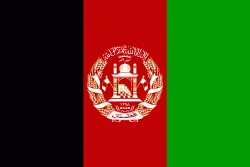Kuh-e Bandaka (Kōh-e Bandakā)
Kuh-e Bandaka (Pashto: کوه بندکا) or Kohe Bandaka, Koh-i Bandaka, Bandako, or incorrectly Koh-i-Bandakor ) is one of the highest peaks of the Hindu Kush mountain range in northeastern Afghanistan. It is northeast of Kabul and west of Chitral. Separated by a relatively low pass from the core of the Hindu Kush, it is the second highest mountain entirely within Afghanistan, and the most topographically prominent peak in all of Afghanistan.
On September 22, 1960, the second German expedition to visit the Hindu Kush made the first ascent of Kuh-e Bandaka. The members of the expedition were Wolfgang von Hansemann, Dietrich Hasse, Siegbert Heine, and Johannes Winkler, all from West Berlin; all attained the summit. They made four camps, with their base camp in the Dare-Sachi Valley at an altitude of 4100 m. The expedition also made multiple first ascents in the Pagar Valley of the Hindu Kush, and made meteorological and geological observations and sketch maps.
There have been over fifteen subsequent ascents, via a variety of routes; however there have been no recorded ascents since 1977.
On September 22, 1960, the second German expedition to visit the Hindu Kush made the first ascent of Kuh-e Bandaka. The members of the expedition were Wolfgang von Hansemann, Dietrich Hasse, Siegbert Heine, and Johannes Winkler, all from West Berlin; all attained the summit. They made four camps, with their base camp in the Dare-Sachi Valley at an altitude of 4100 m. The expedition also made multiple first ascents in the Pagar Valley of the Hindu Kush, and made meteorological and geological observations and sketch maps.
There have been over fifteen subsequent ascents, via a variety of routes; however there have been no recorded ascents since 1977.
Map - Kuh-e Bandaka (Kōh-e Bandakā)
Map
Country - Afghanistan
 |
 |
| Flag of Afghanistan | |
Human habitation in Afghanistan dates back to the Middle Paleolithic era, and the country's strategic location along the historic Silk Road has led it to being described, picturesquely, as the ‘roundabout of the ancient world’. Popularly referred to as the graveyard of empires, the land has historically been home to various peoples and has witnessed numerous military campaigns, including those by the Persians, Alexander the Great, the Maurya Empire, Arab Muslims, the Mongols, the British, the Soviet Union, and most recently by a US-led coalition. Afghanistan also served as the source from which the Greco-Bactrians and the Mughals, amongst others, rose to form major empires. The various conquests and periods in both the Iranian and Indian cultural spheres made the area a center for Zoroastrianism, Buddhism, Hinduism, and later Islam throughout history.
Currency / Language
| ISO | Currency | Symbol | Significant figures |
|---|---|---|---|
| AFN | Afghan afghani | Ø‹ | 2 |
| ISO | Language |
|---|---|
| PS | Pashto language |
| FA | Persian language |
| TK | Turkmen language |
| UZ | Uzbek language |















